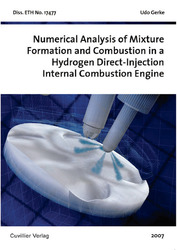| Departments | |
|---|---|
| Book Series (96) |
1377
|
| Nachhaltigkeit |
3
|
| Gesundheitswesen |
1
|
| Humanities |
2361
|
| Natural Sciences |
5403
|
| Engineering |
1788
|
| Engineering | 291 |
| Mechanical and process engineering | 861 |
| Electrical engineering | 685 |
| Mining and metallurgy | 30 |
| Architecture and civil engineering | 75 |
| Common |
97
|
|
Leitlinien Unfallchirurgie
5. Auflage bestellen |
|
Advanced Search
Numerical Analysis of Mixture Formation and Combustion in a Hydrogen Direct-Injection Internal Combustion Engine (English shop)
Udo Gerke (Author)Preview
Table of Contents, Datei (54 KB)
Extract, Datei (54 KB)
The present work investigates the mixture formation and combustion process of a direct-injection (DI) hydrogen internal combustion engine by means of three-dimensional numerical simulation. The study specifies details on the validity of turbulence models, combustion models as well as aspects on the definition of hydrogen-air burning velocities with respect to hydrogen IC engine applications. Results of homogeneous, stratified and multi-injection engine operation covering premixed, partially premixed and non-premixed combustion of hydrogen are presented. Results of the numerical simulations are validated using data of experimental analysis from parallel works, employing a one-cylinder research engine and a research engine with optical access. As a fundamental contribution to combustion modelling of hydrogen IC engines, a new correlation for laminar burning velocities of hydrogen-air mixtures at engine-relevant conditions is derived from measurements of premixed outwards propagating flames conducted in a single-cylinder compression machine.
Numerical results of the direct-injection mixture formation give a detailed understanding of the interrelation between injection timing and the degree of mixture homogenisation. A favourable agreement between the computed fuel concentration and results of Planar Laser Induced Fluorescence (PLIF) measurements is reported for various injection timings. Different two-equation turbulence models, a Shear Stress Transport (SST) model and a k-ε model based on Renormalisation Group (RNG) theory as well as a Reynolds Stress Model (RSM) are discussed. The impact of the models on the level of turbulent kinetic energy proves to be of major importance.
State-of-the-art turbulent combustion models on the basis of turbulent flame speed closure (TFC) and on the basis of a flame surface density approach, the Extended Coherent Flame Model (ECFM), are examined. The models are adapted to hydrogen internal combustion engines and are interfaced to the established three-dimensional flow field solver ANSYS CFX within the framework of the international research project HyICE. Two different approaches are investigated as input for the laminar burning velocities of hydrogen. Firstly, flame speed data are computed with a kinetic mechanism. Secondly, an existing experimentally derived laminar flame speed correlation is extended to rich air/fuel equivalence ratios (λ < 1) and is compared to measurements conducted within the present work. In general, the TFC-models show a satisfying agreement for DI operating points compared to experimental data, when mixing computations are conducted with the SST turbulence model. Also, port fuel injection (PFI) operating points demonstrate a good performance with these models, however, the constant model prefactor (multiplier for the closure of turbulent flame speed) has to be defined individually for PFI and DI computations. This effect might be caused by the dissimilar sources of turbulence for the two engine types (PFI and DI) which cannot be adequately predicted by the turbulence models. Combustion computations on the basis of mixture results obtained by the RNG-model generally underrate the level of turbulence intensity for stratified operation points, effecting too weak rates of heat release. The ECFM combustion model shows a satisfying predictability for the PFI case using a constant model prefactor. Computations of DI operating points with this model, however, require a readjustment of the prefactor for each operating point in order to match experimental results.
Regarding turbulent combustion, the hydrogen laminar flame speed is recognised to be the crucial quantity for the employed modelling approaches. Since direct-injection hydrogen engines in the stratified case engender a wide range of equivalence ratios, fundamental data for the laminar flame speed has to be provided as a model input within the entire boundaries of ignition limits. A lack of experimental data of laminar flame speed at engine-relevant conditions (high pressure, high temperature) is noticed. In order to perform a detailed study on hydrogen burning velocities, a single-cylinder compression machine is selected to conduct flame speed measurements of hydrogen-air mixtures at ignition temperatures and pressures up to T = 700 K and p = 45 bar, considering air/fuel equivalence ratios between λ = 0.4 and 2.8. Flame front velocities are acquired by means of optical methods using OH-chemiluminescence and thermodynamic, multi-zone evaluation of pressure traces. In comparison to data of laminar flame speed derived from reaction mechanisms and flame speed correlations found in literature, the experimental results show increased burning velocities due to flame front wrinkling caused by hydrodynamic and thermo-diffusive instabilities.
Home at Hydrogen Engine
EU Transport Research
| ISBN-13 (Printausgabe) | 3867274991 |
| ISBN-13 (Hard Copy) | 9783867274999 |
| ISBN-13 (eBook) | 9783736924994 |
| Language | English |
| Page Number | 232 |
| Edition | 1 |
| Volume | 0 |
| Publication Place | Göttingen |
| Place of Dissertation | Stuttgart |
| Publication Date | 2008-02-05 |
| General Categorization | Dissertation |
| Departments |
Engineering
Mechanical and process engineering |
| Keywords | Hydrogen, Engine, CFD, Combustion Model, Laminar Flame Speed, Burning Velocity, LIF, Direct Injection. |








